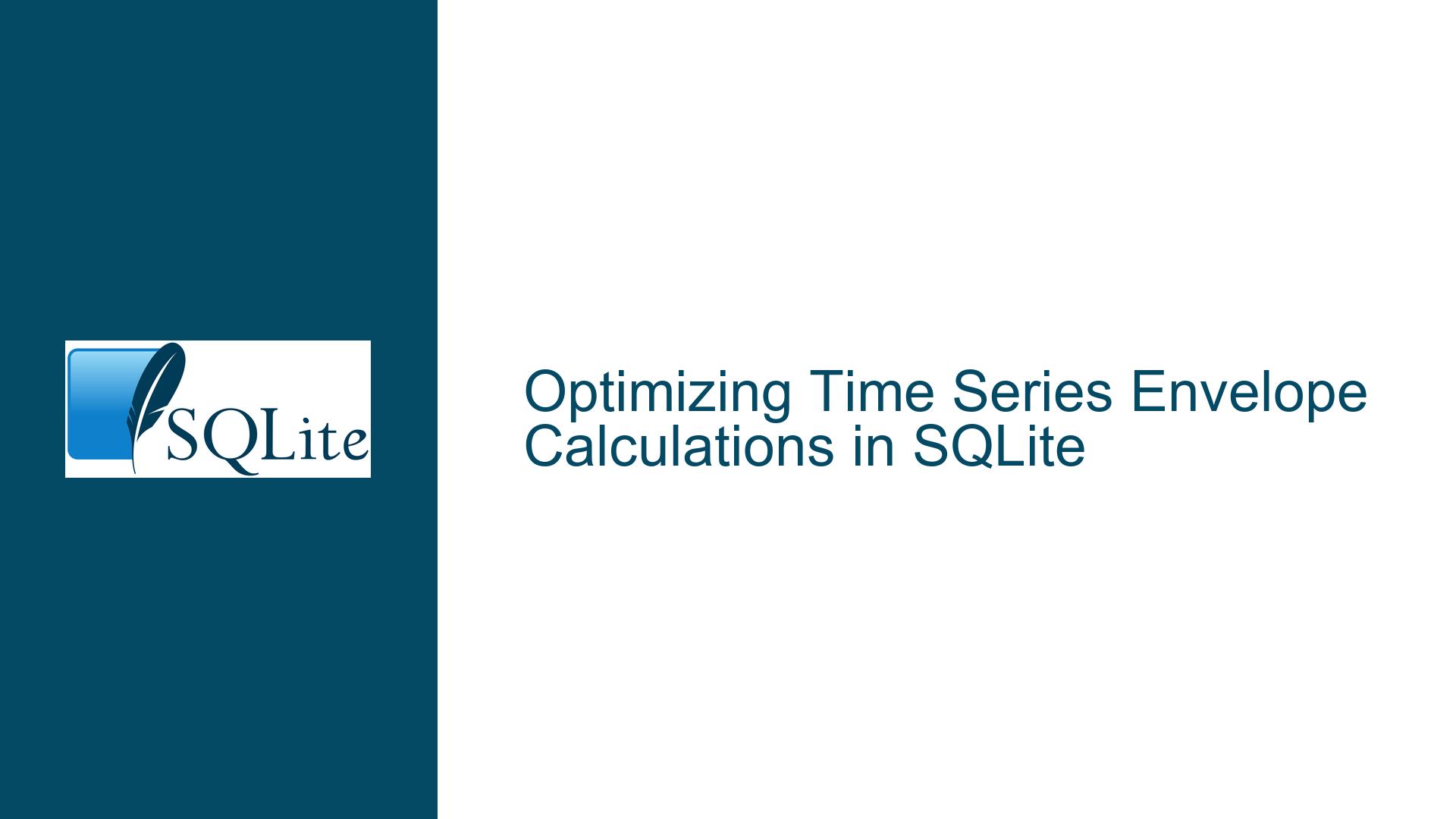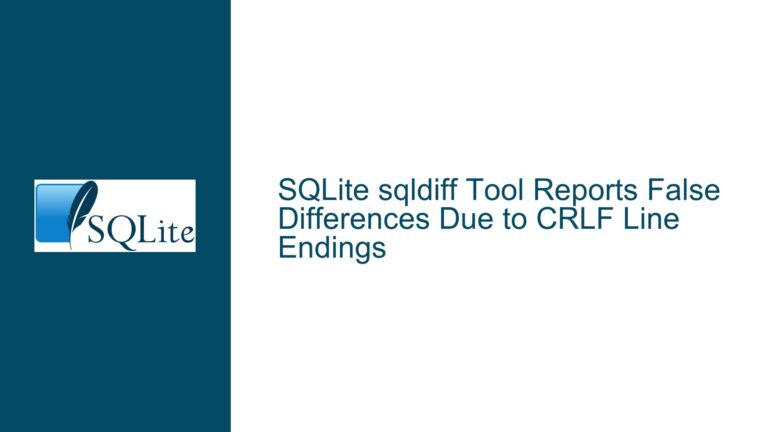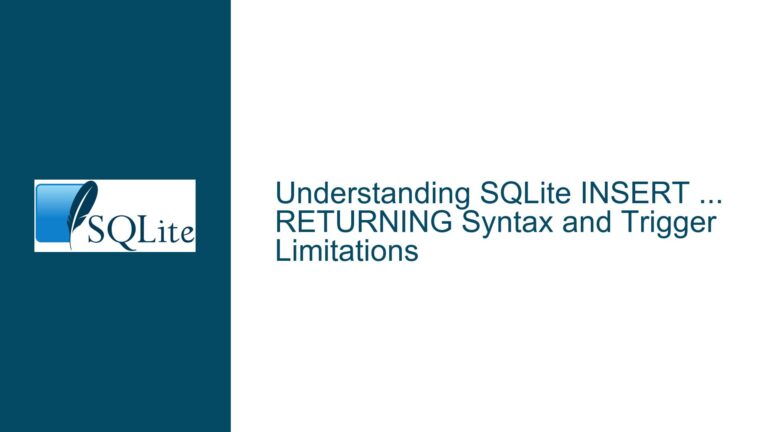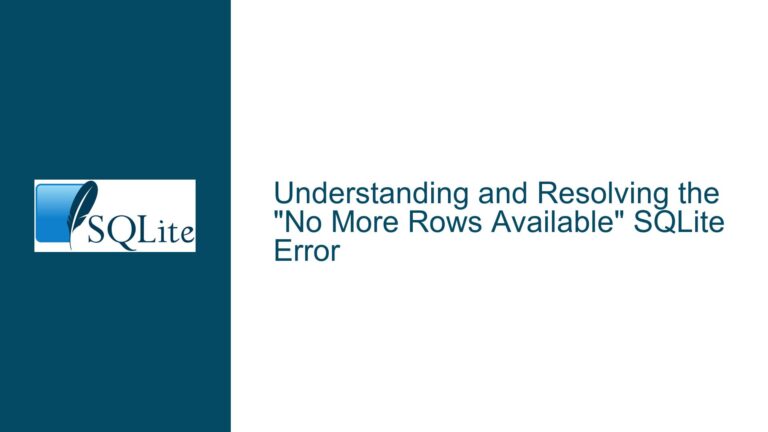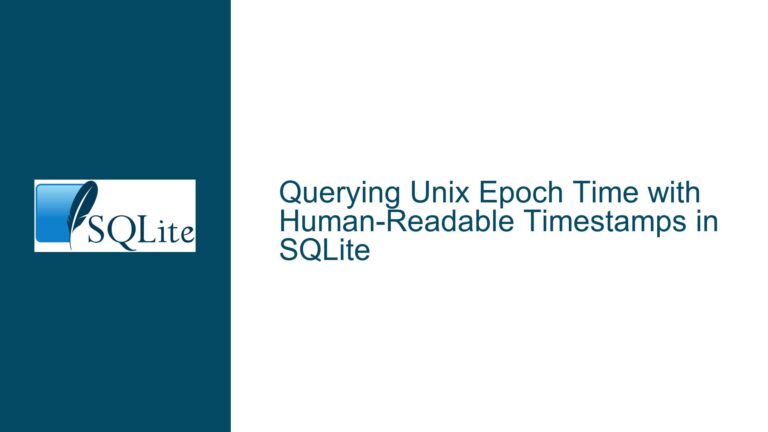Optimizing Time Series Envelope Calculations in SQLite
Handling Large-Scale Time Series Data Across Multiple SQLite Databases
When dealing with large-scale time series data distributed across multiple SQLite databases, the primary challenge lies in efficiently calculating aggregate metrics such as minimum, maximum, and mean values for each time step across all datasets. This scenario often arises in scientific computing, financial analysis, or IoT applications where data is generated in discrete chunks (e.g., per computation case or device). The core issue revolves around whether to process the data in its distributed form or consolidate it into a single database before performing calculations. Each approach has trade-offs in terms of performance, complexity, and scalability.
The distributed approach involves iterating through each database file, extracting the relevant time series data, and computing the aggregates programmatically. This method avoids the overhead of merging data into a single database but requires careful handling of file I/O and synchronization across threads. On the other hand, the consolidated approach involves merging all time series data into a single SQLite database with an additional column to identify the source case. This simplifies querying but introduces challenges related to database size, indexing, and query optimization.
The choice between these approaches depends on factors such as the alignment of time steps across datasets, the volume of data, and the computational resources available. Additionally, SQLite’s limitations in handling very large datasets or complex queries must be considered. For instance, while SQLite excels at lightweight, single-file database management, it may struggle with performance when dealing with billions of rows or highly concurrent operations. Understanding these nuances is critical to designing an efficient solution.
Misaligned Time Steps and Aggregation Challenges
One of the key assumptions in the proposed solution is that the time steps across all datasets are perfectly aligned. In real-world scenarios, this assumption may not hold true due to variations in data collection intervals, clock drift, or missing data points. Misaligned time steps complicate the aggregation process because simple GROUP BY queries will not yield accurate results. For example, if one dataset has a time step at 0.1 seconds and another at 0.15 seconds, aggregating these values directly would lead to incorrect min, max, and mean calculations.
To address this, preprocessing steps may be required to align the time steps across all datasets. This could involve interpolating missing values, resampling the data to a common time grid, or identifying the nearest time step for each dataset. These operations can be computationally expensive, especially when dealing with thousands of datasets. Furthermore, the choice of interpolation or resampling method can significantly impact the accuracy of the results. For instance, linear interpolation may suffice for smoothly varying data, but more complex methods like spline interpolation may be necessary for highly variable time series.
Another challenge is handling datasets with different lengths or missing data. If one dataset has fewer time steps than others, aggregating values across all datasets may result in incomplete or skewed results. In such cases, it may be necessary to pad the shorter datasets with placeholder values or exclude them from the aggregation process. However, these workarounds introduce additional complexity and potential sources of error.
Efficient Query Design for Envelope Calculations
Assuming the time steps are aligned, the next challenge is designing efficient SQL queries to calculate the min, max, and mean values for each time step across all datasets. The proposed query in the discussion uses the GROUP BY clause to aggregate values by time step:
SELECT tstep, MIN(var_a), MAX(var_a), AVG(var_a) FROM Table GROUP BY tstep;
While this query is straightforward, it may not perform well on large datasets due to SQLite’s limitations in handling complex aggregations. For instance, calculating the min, max, and mean values for each time step requires scanning the entire dataset, which can be slow for tables with millions of rows. Additionally, if the dataset includes multiple variables (e.g., var_a, var_b, var_c), the query must be repeated for each variable, further increasing the computational load.
To optimize performance, consider the following strategies:
Indexing: Create an index on the
tstepcolumn to speed up the GROUP BY operation. This reduces the time required to locate and aggregate values for each time step. However, indexing comes with trade-offs, such as increased storage requirements and slower write operations.Batch Processing: If the dataset is too large to process in a single query, break it into smaller batches and process each batch separately. This reduces memory usage and allows for parallel processing using multiple threads or processes.
Materialized Views: Precompute and store the aggregated results in a separate table or materialized view. This avoids recalculating the aggregates every time they are needed, at the cost of additional storage and maintenance overhead.
Approximate Aggregations: If exact values are not required, consider using approximate aggregation functions like SQLite’s
approx_count_distinctor custom implementations for min, max, and mean. These functions trade accuracy for speed, making them suitable for large datasets.Hybrid Approach: Combine SQL queries with programmatic processing to leverage the strengths of both methods. For example, use SQL queries to extract subsets of data and perform the final aggregation in memory using C++ or another high-performance language.
Data Consolidation vs. Distributed Processing
The decision to consolidate data into a single database or process it in its distributed form depends on several factors, including the size of the datasets, the alignment of time steps, and the available computational resources. Consolidating data simplifies querying and allows for more efficient use of SQLite’s features, such as indexing and transactions. However, it also introduces challenges related to database size, write performance, and concurrency.
For example, merging 2,000 databases, each containing 60,000 rows (6000 seconds divided into 0.1-second steps), results in a single table with 120 million rows. While SQLite can handle tables of this size, performance may degrade due to increased I/O operations and memory usage. Additionally, inserting data into a large table can be slow, especially if indexes are present. To mitigate these issues, consider using bulk insert operations, disabling indexes during the insert process, and re-enabling them afterward.
On the other hand, distributed processing avoids the overhead of consolidating data but requires careful coordination across multiple files. This approach is well-suited for parallel processing, as each database file can be processed independently. However, it also introduces challenges related to file I/O, thread synchronization, and error handling. For instance, if one of the database files is corrupted or inaccessible, the entire process may fail unless proper error handling mechanisms are in place.
Advanced Techniques for Large-Scale Time Series Analysis
For scenarios involving extremely large datasets or complex analyses, consider leveraging advanced techniques and tools beyond SQLite. For example:
Database Sharding: Split the data across multiple SQLite databases based on a sharding key, such as time range or case number. This reduces the size of each database and improves query performance. However, it also increases the complexity of querying and aggregating data across shards.
External Tools: Use specialized time series databases like InfluxDB or TimescaleDB, which are optimized for handling large-scale time series data. These databases offer features like automatic data retention, downsampling, and efficient aggregation functions.
Data Lakes: Store the raw data in a distributed file system like Hadoop or Amazon S3 and use tools like Apache Spark or Presto for distributed processing. This approach is highly scalable but requires significant infrastructure and expertise.
Custom Algorithms: Implement custom algorithms for envelope calculations using high-performance languages like C++ or Rust. These algorithms can be optimized for specific use cases and hardware, providing better performance than generic SQL queries.
Conclusion
Optimizing time series envelope calculations in SQLite requires a deep understanding of the data, the tools, and the trade-offs involved. Whether you choose to consolidate data into a single database or process it in its distributed form, careful planning and optimization are essential to achieving good performance. By addressing challenges such as misaligned time steps, inefficient queries, and large dataset sizes, you can design a solution that meets your specific requirements. Additionally, exploring advanced techniques and tools can provide further improvements in scalability and efficiency.
